![]()
![]()
![]()
Use LEFT and RIGHT arrow keys to navigate between flashcards;
Use UP and DOWN arrow keys to flip the card;
H to show hint;
A reads text to speech;
67 Cards in this Set
- Front
- Back
|
Where does the temporal bone articulate with the mandible? Via what structure?
|
Mandibular Condyle (head) via ARTICULAR disk
|
|
|
Where does the temporalis muscle attach on the mandible?
|
Coronoid Process
|
|
|
What motions of the mandible are achieved via the temporomandibular joint?
|
Protrusion, Retrusion
Elevation, Depression |
|
|
In what position is the TMJ normally disarticulated?
|
Protruded position (easily caught in forward position)
|
|

|

|
|
|
Attachments of masseter.
Action? Innervation? |
Masseter: zygomatic arch-->mandibular angle
Action: Jaw elevation Innervation: V3 |
|
|
Attachments of digastric.
Action? Innervation? |
Digastric:
Posterior belly: Mastoid-->Hyoid Anterior belly: Hyoid-->Mandible Action: Jaw DEPRESSION Innervation: Posterior Belly: Facial (VII) Anterior Belly: V3 |
|
|
Attachments of temporalis.
Action? Innervation? |
Temporalis: parietal-->coronoid process
Action: Elevation AND Retrusion Innervation: V3 |
|
|
Attachments of lateral pterygoid.
Action? Innervation? |
Lat pterygoid: Sphenoid-->Mandibular condyle
Action: Protrusion Innervation: V3 |
|
|
Attachments of mylohyoid.
Action? Innervation? |
Hyoid-->Mandible
Action: depresses mandible Innervation: V3 |
|
|
Action of medial pterygoid.
Innervation? |
Medial Pterygoid: elevation (mainly) and protrusion
V3 |
|
|
Attachment of geniohyoid.
Action? Innervation? |
Mandible-->Hyoid
Action: Depresses mandible Innervation: C1 |
|
|
Action of infrahyoid muscles.
Innervation? |
Stabilize hyoid
Ansa Cervicalis C1-C3 |
|
|
|
|
|

|

|
|

|
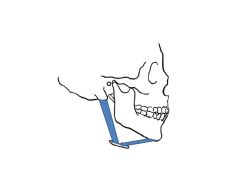
|
|
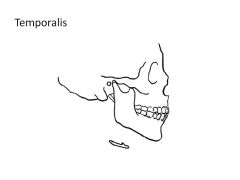
|

|
|
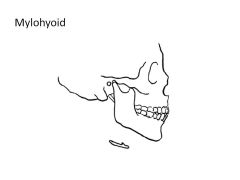
|

|
|

|
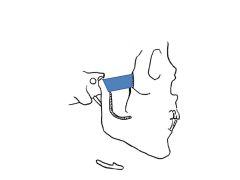
|
|

|

|
|

|

|
|

|

|
|

|

|
|

|

|
|
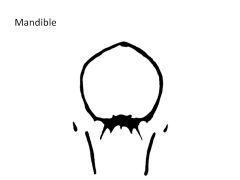
|

|
|

|
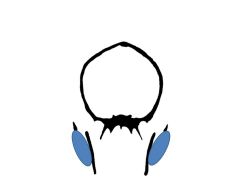
|
|

|

|
|
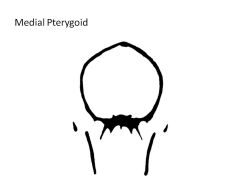
|

|
|
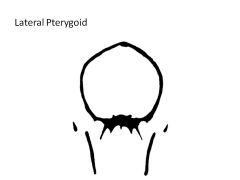
|

|
|
|
During mastication, what movements are required for jaw opening?
What muscles convey these movements? |
Jaw opening:
Depression: digastric, mylohyoid, geniohyoid; infrahyoid mm stabilize hyoid Lateral movement TOWARD working side: lateral pterygoid on balancing side (unilateral protrusion) |
|
|
During mastication, what movements are required for jaw closing?
What muscles convey these movements? |
Jaw closing:
Elevation: temporalis, masseter, medial pterygoid (occurs bilaterally; high force transmitted through mandibular symphysis) Lateral movement toward balancing side: 1) Closing stroke: posterior temporalis on balancing side (unilateral retrusion) 2) Power stroke: medial and lateral pterygoid on working side |
|
|
Innervation of pharyngeal constrictors?
Action? |
Innervation: Vagus
Action: Swallowing |
|
|
Describe the 4 stages of swallowing. Be sure to include:
1) Voluntary vs Involuntary 2) Speed |
1) Voluntary and slow: tongue pushes bolus back against hard palate, passes into oropharynx
2) Involuntary and fast: soft palate elevates, seals off nasopharynx, larynx moves up and forward, Epiglottis closes 3) Involuntary and fast: pharyngeal constrictors contract to produce "explosive" swallowing, food forced down into esophagus 4) Explosive swallowing cont'd: Bolus moves down esophagus by peristalsis |
|
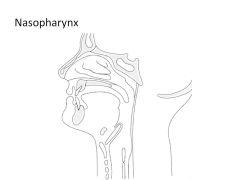
|

|
|

|

|
|

|
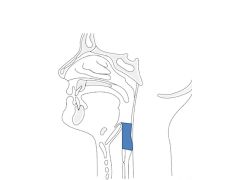
|
|

|

|
|
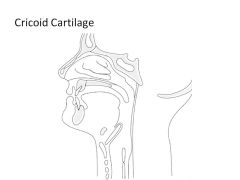
|

|
|
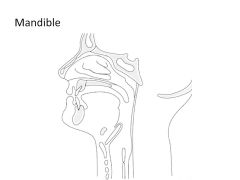
|

|
|

|
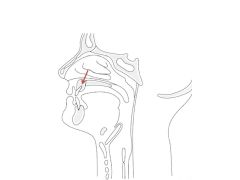
|
|

|
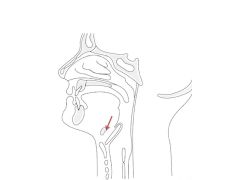
|
|

|
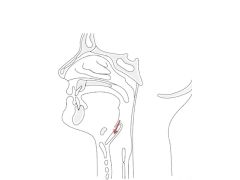
|
|

|
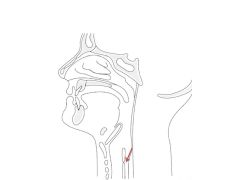
|
|

|

|
|

|

|
|

|

|
|

|

|
|

|

|
|

|
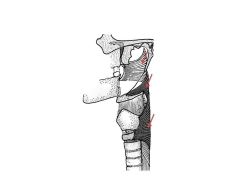
|
|
|
What is the posterior attachment of the vocal folds?
|
Arytenoid Cartilage
|
|
|
Action of cricothyroid muscle?
|
Rotates thyroid cartilage about cricothyroid joint ANTERIORLY to put vocal folds at higher tension (achieves higher pitch)
|
|
|
How is higher pitch achieved?
|
Increase tension of vocal folds by rotating thyroid cartilage ANTERIORLY about cricothyroid joint via CRICOTHYROID MUSCLE
|
|
|
What muscles are required for abduction of the vocal cords?
What is abduction necessary for? |
Posterior cricoarytenoid m
For breathing |
|
|
What muscles are required for adduction of the vocal folds?
What is adduction necessary for? |
Rotation: Lateral cricoarytenoid m
Sliding: Transverse arytenoid, Oblique arytenoid Phonation |
|
|
How is a low pitch achieved?
|
Vocal cords relax via Thyroarytenoid muscle and Vocalis
|
|
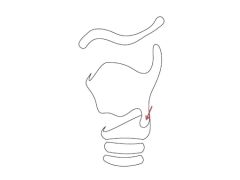
|

|
|

|

|
|

|

|
|

|
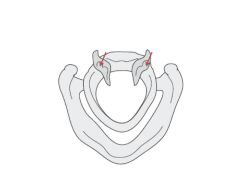
|
|

|

|
|

|

|
|
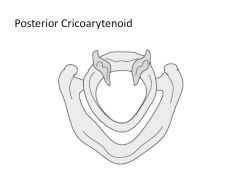
|

|
|

|

|
|
|
|
|
|

|

|
|
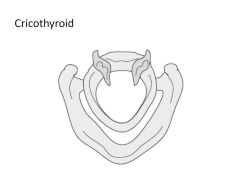
|

|
|

|
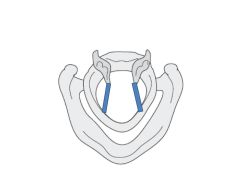
|

